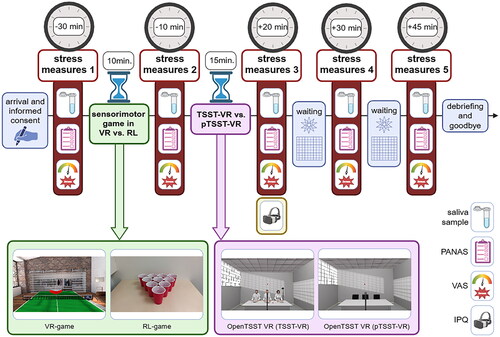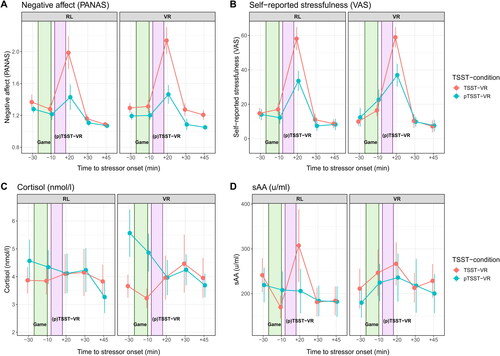Figures & data
Figure 1. Overview over the experimental design of the current study.
Note. Stress measures covered saliva samples as well as self-report measures of stress and affect. Saliva samples were taken in form of Salivettes® (Sarstedt, Nümbrecht, Germany) and were analyzed for salivary cortisol concentrations and salivary alpha-amylase (sAA) activity. Subjective measures comprised the Positive and Negative Affect Schedule (PANAS) and a verbal analogue scale (VAS). For the VAS, participants were instructed to rate the stressfulness of the previous situation on a scale from 0 to 100. Timepoints of the stress and affect measures are given relative to stressor onset (i.e., onset of TSST-VR or pTSST-VR). On the bottom, there are screenshots/photos of the VR-game (VR = virtual reality), the RL-game (RL = real life), the TSST-VR, and the pTSST-VR, respectively. The VR-game was screenshotted from ©ElevenTable Tennis, By For Fun Labs, Inc., Austin, Texas. The Igroup Presence Questionnaire (IPQ) was given in parallel to our third assessment of stress and affect measures to capture perceived immersion of participants during the TSST-VR or pTSST-VR. Created with BioRender.com.

Table 1. Demographic sample characteristics and descriptive aggregated stress and affect measures.
Figure 2. Repeated stress and affect measures.
Note. Depicted are repeated stress and affect measures over the course of the experiment, separate for all four experimental conditions (VR-game + TSST-VR, RL-game + TSST-VR, VR-game + pTSST-VR, RL-game + pTSST-VR), including the mean and standard error of the mean at all points in time (T1: -30 min, T2: -10 min, T3: +20 min, T4: +30 min, T5: +45 min relative to stressor onset). Duration of the game (either in VR or in RL) is illustrated in green. Duration of the TSST-VR or pTSST-VR is illustrated in violet. Each panel (A-D) is divided for game-conditions, with the RL-condition on the left, and the VR-condition on the right. TSST-conditions are illustrated using different colors: red lines illustrate trajectories within the TSST-VR-group, whereas blues line reflect dynamics for the pTSST-VR-group. A: negative affect, as assessed by means of the PANAS, B: self-reported stressfulness as given by means of the VAS, C: raw (untransformed) cortisol level (nmol/l), D: raw (untransformed) sAA activity (nmol/l).

